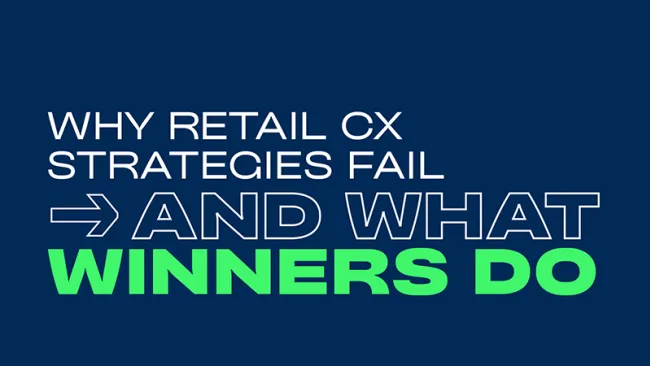In the face of media reports that the state of retail is weakening, shopping is not dead. In-store and online buying continues to remain popular. More than 40 percent of consumers make purchases inside of a store at least once a week, according to PwC’s annual consumer survey. Meanwhile, the number of online shoppers continues to grow, as more than 200 million U.S. consumers will go online to shop this year, increasing to more than 215 million by 2018, according to Statistica.
Still, despite the industry’s potency, retailers need to break bad habits and rethink their approaches to customer engagement to deliver the kinds of experiences that enchant consumers and keep them loyal. For instance, some retailers use advertising and messaging that promote a brand promise for products and services that don’t extend to the customer experience. When consumers don’t receive consistent experiences from a company—whether for customer support or the channels they use for research and purchases—they won’t hesitate to shift their allegiance to brands that can deliver on their expectations.
Here are four ways retailers can break bad habits and rise above the noise to stand out as customer experience leaders:
Bad Habit #1: Slick advertising doesn’t match the customer experience
Break it by: Keeping your promise to customers
Many retailers fail to live up to the expectations they themselves create through marketing and advertising. It’s not just an industry problem—81 percent of global companies are not committed to executing customer experience strategies, according to a 2014 study by Strativity Group.
Regardless, delivering on the brand promise is critical in retail where customer loyalty is ambiguous. Customers regularly cross-channel shop with competitive retailers—both in-store and elsewhere. This can make it difficult for merchants to preserve loyalty and retain customers.
Still, research shows that consumers are willing to stay loyal to a small number of retailers when their expectations are met. When asked for the number one reason consumers shop with a favorite retailer, brand trust is cited by 86 percent of respondents, according to a 2014 study by PwC based on 15,000+ online surveys with global consumers.
There are a number of ways that brand trust can be fostered by retailers through delivering on the brand promise. As Don Peppers and Martha Rogers, Ph.D., founding partners of Peppers & Rogers Group point out in their book Extreme Trust, the building blocks of customer trust are competence and intent: does a company have the competence to deliver on customer needs and expectations, and does the organization act with a customer’s best interests in mind?
For retailers, competence can be demonstrated by delivering on the brand promise to customers. This includes providing products and services through the touchpoints that customers want to use while enabling customers to access them easily and conveniently.
A retailer can also validate its competence by providing customers with frictionless support when they reach out for assistance. This includes making it effortless for customers to transition from one channel (e.g., web self-service) to another (live associate) when they do require product or service support. A well-integrated contact center platform enables associates to determine the nature of an issue a customer is trying to resolve, along with the channel the customer most recently used in order to provide relevant and seamless support. In addition, a contact center platform that provides full connectivity to other customer technologies such as CRM systems gives associates with a 360-degree view of each customer. Having a complete picture of each customer enables associates to offer highly personalized and relevant support.
Meanwhile, retailers can strengthen customer trust by acting on behalf of customers. For instance, by analyzing a customer’s most recent product purchases, along with information about their current lifecycle status and other personal characteristics, a retailer can extend an offer for a relevant product that’s squarely in the customer’s best interest—even if that product carries a lower profit margin than another one that could be suggested.
Amazon and Apple are examples of two retailers that are proactively trustworthy. They also happen to be in the top 10 of Brand Keys’ 2014 Customer Loyalty Engagement Index. If a customer attempts to buy a song that he previously purchased, each of these retailers will remind him that he already owns it. When a customer believes that a retailer has his back and is truly delivering on the brand promise, that’s an awesome way to build loyalty.
Bad habit #2: Blinded by sales targets
Break it by: Using technology to benefit customers, not just drive sales
Many retailers use customer data—including purchase history, product interest, channel usage, and other types of information—to identify the best opportunity for selling the most profitable product or service possible to a particular consumer. The problem with this tactic is that it may benefit the company’s bottom line for the short term, but wipe out long-term customer value by focusing on the retailer’s needs, not the customer’s.
Retailers can draw off unique information they have about customers, including demographics, lifestyle status, transactional, behavioral, and sentimental data to identify the next best action to take with a customer that’s based on their best interest. Providing customers with offers that are focused on benefitting the customer can help strengthen active customer relationships or rejuvenate dormant bonds.
A retailer can offer product recommendations that may interest a particular customer based on her previous transactions and lifecycle status. For instance, a high-value customer who has consistently purchased children’s clothing from a department store could be sent an offer for a steep discount on children’s winter clothing accessories (hats, gloves, scarves) in advance of an expected cold snap as a way of thanking the customer for her continued patronage.
Bad habit #3: Front-line staff isn’t a corporate priority
Break it by: Enabling the human connection, a powerful differentiator
Leaders like to say that a company’s employees are its greatest asset, particularly customer-facing ones. But, they usually don’t invest in employee training or take adequate steps to strengthen employee engagement.
But what can the in-store experience offer that online competitors can’t? People. One reason consumers continue to value the in-store experience is the ability to receive assistance from knowledgeable staff when needed.
ho are knowledgeable about a retailer’s primary product offerings (e.g. technology, fashion, sporting goods, home improvements) and have the requisite communication skills can truly differentiate the customer experience.
Customers expect to interact with knowledgeable in-store employees. A 2014 Forrester Research study reveals that 68 percent of consumers expect sales associates to be experts on products offered in-store. A customer who walks into a store and asks an associate for specific product or warranty details is going to be disappointed if he isn’t given the information he’s looking for. That customer will also likely take his business to a retailer who can meet his needs more effectively.
Product and market intelligence can enable in-store and contact center associates to meet customer expectations. For instance, a sporting goods customer who reaches out to a retailer’s contact center for information about golf equipment can be routed to the appropriate associate who is most knowledgeable about the products or category the customer is calling about.
Recruiting the right in-store and contact center associates can be aided by the use of cutting-edge candidate assessment tools. State-of-the-art tools can be used to help identify and hire associates with suitable knowledge, communication, and channel skills to meet customer expectations. Plus, the recruitment and retention of highly skilled staff can boost productivity and lower the cost to serve, while increasing customer satisfaction and word-of-mouth referrals.
Bad habit #4: Customer acquisition trumps retention
Break it by: Re-engaging with estranged customers in a meaningful way
One of the biggest challenges many retailers face is winning back customers who have departed due to poor experiences, better perceived value from other retailers, or other reasons. Often retailers are so focused on acquiring new customers that they overlook the need to reward and incentivize loyal customers who provide the business with recurring revenue streams.
There are numerous ways to use customer data, analytics, and other technologies to identify inactive customers and to reconnect with them. As a starting point, transaction data can enable retailers to identify dormant customers. Relevant content based on what’s known about a customer can then be used for re-engagement opportunities.
Meanwhile, behavioral information can also be used to reconnect with a latent customer. For instance, when a former or infrequent customer searches online for certain products or services, a retailer can place an advertisement focused on the customer’s expressed interests and geographic location to generate attention to its offerings.
In some cases, customers disengage with brands after tuning out to ‘batch and blast’ email campaigns. Retailers can use purchasing data and other information known about a detached customer to send personalized messages, such as a sale offer on a favorite brand.
Reaching out directly to disengaged customers can also help retail leaders to understand why they left. Feedback shared by inactive customers can often be used to help business leaders better understand the needs of active customers or identify service or product issues that should be addressed.
In addition, taking the time to speak with idle customers and share recent changes that have been made to improve the customer experience based on their feedback can often help bring them back into the fold.
Disengaged customers offer a tremendous opportunity for retailers to test out new strategies for re-engagement. Drawing on customer information and the use of analytics is a great way to engage with active patrons and to re-connect with detached customers. The use of customer data also presents incredible opportunities to strengthen customer relationships through deeper engagement and to fortify loyalty.















